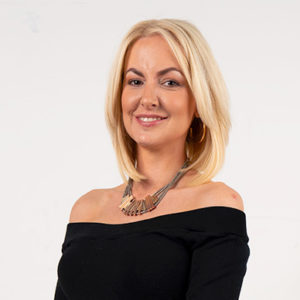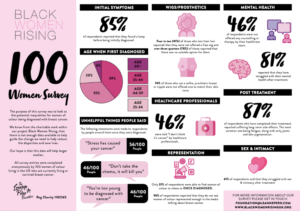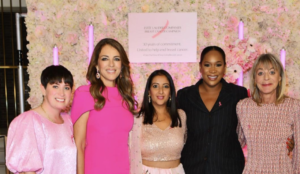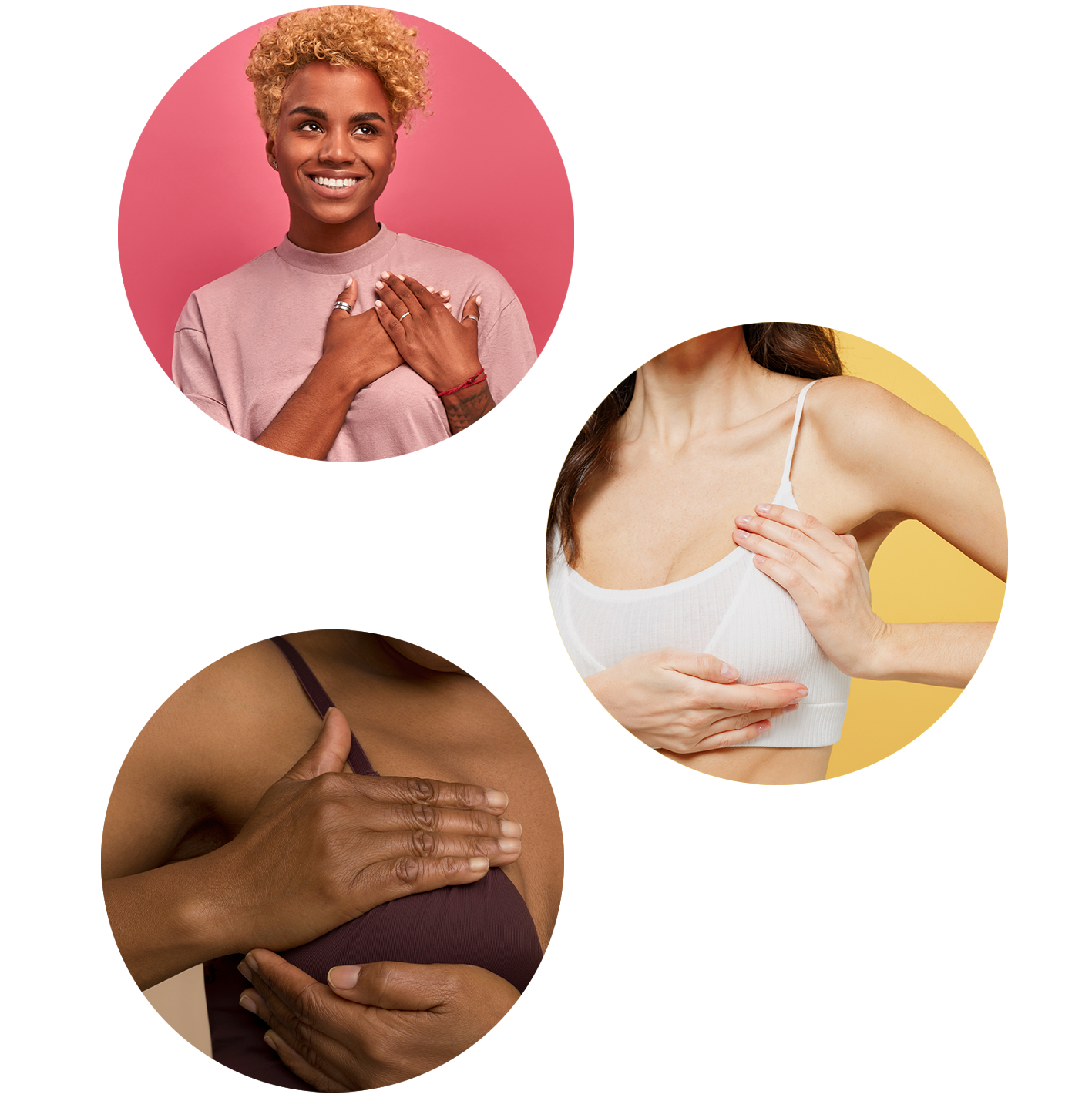 This post is written by our Strategy Director, Caragh Logan, a breast cancer survivor with 15 years of brand strategy experience and a focus on diversity and inclusion. Here, Caragh shares her personal and professional opinion on how brands continue to get Breast Cancer Awareness Month (BCAM) so wrong.
This post is written by our Strategy Director, Caragh Logan, a breast cancer survivor with 15 years of brand strategy experience and a focus on diversity and inclusion. Here, Caragh shares her personal and professional opinion on how brands continue to get Breast Cancer Awareness Month (BCAM) so wrong.
From the moment of diagnosis, people with breast cancer enter a life-altering tornado of events. If they’re lucky enough to survive, the physical, mental, personal, financial and social consequences of their experience will ensure they’ll never be the same again.
Each year, around 55,000 women and 350 men are diagnosed with breast cancer in the UK. It’s one of the best-funded areas of cancer research worldwide. That’s why breast cancer patients are often told they’re ‘lucky’ they got ‘the good cancer’. Spoiler alert – there’s no such thing. Despite the extensive research budget, 31 women die from secondary breast cancer in the UK every day. A significant contributing factor to that figure is because in North America and the UK, just 5 – 7% of funding is dedicated to researching secondary breast cancer – the stage of the disease that causes death.
Yet still, every October UK retailers, fashion brands and media turn pink in a bid to “raise awareness” during BCAM. What’s wrong with that, you ask? Let me explain.
The Branding Issue
When developing a brand, you take an entity, dig into its vision and develop visual, verbal, written and experiential cues that help shape the way audiences think about it. At Jérrard Wayne, we call this aligning perception with purpose. When those cues are laden with biases and stereotypes, or fail to resonate with the intended audience, success is limited.
Unfortunately, as with most creative industry top jobs, brand and marketing leadership roles have traditionally been held by middle-aged white men who influence decision-making with their world view. This means outdated ideas often creep into brand messaging, reinforcing misogynistic attitudes about women, femininity and sex. As a result, marketing and advertising have long profited from women’s bodies, creating a warped relationship with breasts in particular. Society generally views breasts as objects of desire or tools for nurturing. Always intended for anyone except the woman who has them.
God forbid women get to take ownership of their bodies so that when we picture a woman going through a breast cancer diagnosis, we see the fullness of their identities. Instead, breast cancer campaigns tend to reduce women to their diagnoses in one of two ways:
1. Pink, fluffy and cutesy campaigns where ‘brave’ celebrities, whose bodies are usually unaffected by cancer, strip to their undies in mainstream media to ‘raise awareness’.
2. ‘Inspirational’ trauma porn featuring older white women – it’s always older white women – looking terribly ill so those not facing their own mortality can feel better about their own lives by pitying others. ‘You’re such an inspiration’ isn’t the compliment you think it is.
Personally, I find both of these creative directions unhelpful to the cause because they don’t reflect the experience of the women, men and non-binary people who one day find themselves sitting in a doctor’s office being told they are facing a life-limiting condition.
Awareness campaigns tend to render people living with and beyond cancer as characterless. Instead, their personality is stripped away, and they are positioned solely as just bodies consumed by disease. When in reality, as with many people who overcome personal adversity, cancer patients are some of the funniest, most formidable, committed-to-really-living people that I have had the pleasure to meet.
The cancer experience is as far removed from the pink and fluffy image of BCAM as you can imagine. While it’s undoubtedly a significant trauma with moments of hopelessness, extreme illness and intense anxiety, it can also be as vivacious as those living with and beyond the disease, as they find and become more embodied in their new normal.
Representation Required
To compound the problem, there is a fundamental lack of diversity and representation in breast cancer campaigns. Women under 40, Black women, Asian women, women from other global majority groups, men, non-binary people, those with disabilities and LGBTQ+ people are often excluded from hospital literature and big brand breast cancer campaigns. This lack of representation has an extreme impact.
It isn’t just a case of awareness campaigns failing these groups. The medical system itself often fails them too, with Black and Asian women having worse outcomes than their white counterparts. The stats are stark:
- Black women are twice as likely to be diagnosed with late-stage cancer than white women.
- 76% of Black women, 63% of South Asian women and 69% of women under 40 are not regularly checking their breasts.
- When prosthetics are necessary, Black and Asian women are usually not offered something that matches their skin tone.
- 96% of women of colour did not see themselves represented in breast cancer awareness campaigns.

(Image courtesy of Black Women Rising.)
In the hope of stopping these issues being ignored, patient advocates have stepped up. Social media has allowed an unlikely community of young cancer patients to emerge, united in their determination to create change. The following women are just three examples of changemakers who have become a voice for their communities following their own diagnosis:
- Lauren Mahon and her charity GirlvsCancer address the varied needs of cancer patients under 40.
- Kreena Dhiman is an advocate for South Asian women diagnosed with breast cancer and is passionately vocal about the journey to parenthood through surrogacy following cancer treatment.
- Leanne Pero leads Black Women Rising, a crucial charity working to raise awareness around outcomes and representation of Black women dealing with breast cancer.

(Image courtesy of @leannepero Instagram.)
This year, all three of these women have been named as ambassadors for Estée Lauder’s breast cancer campaign work. Their inclusion demonstrates real progress, as one of the world’s most established brands acknowledges the need to look beyond what they know, and to seek the input of advocates with lived experience and invaluable insight.
Pinkwashing
While I would argue that the majority of breast cancer campaigns remain inherently problematic, at least some are explicit about the purpose of their campaign. When a brand suddenly turns pink in October, it’s key that we can easily identify whether they are aiming to raise awareness or funds. It’s also important to question exactly what they are raising awareness about, what percentage of each sale is being donated and where. If these things aren’t clear, it’s likely you’ve stumbled upon a campaign that’s ‘pinkwashing’.
Similar to when brands ‘greenwash’ to boost their real or imagined climate-conscious credentials, ‘pinkwashing’ is the act of a brand of using breast cancer ‘awareness’ to promote their products. They’ll often go to the lengths of repackaging their product in pink, while making minimal donations to cancer causes and/or continuing to produce and sell products that contain chemicals and carcinogens linked to the disease.
These products drive profits as consumers assume they are contributing to a good cause by purchasing something they may not ordinarily buy. However, this is not always the case. If you want to support through your spending habits, look for products supporting campaigns raising research funds for secondary/stage 4/advanced/metastatic cancer – where your money is most needed.
For more information, check out Pink Is Not The Problem, a resource created by USA-based patient advocacy group, The Breasties.
What People Living With And Beyond Breast Cancer Need From Your Brand
If you’re a brand marketeer thinking about ways your organisation can support those living with and beyond breast cancer, the following five things should be fundamental to your campaign concept.
1. Breast Awareness
Women in the UK are offered mammograms from the age of 50, so the first line of defence for younger people is self-examination. However, even though we know early detection saves lives, 8 out of 10 women do not check their breasts regularly.
If your audience is below 50 years old, you might make the most impact by encouraging breast and body awareness so that any unusual symptoms can be checked early. Coppafeel, the breast cancer awareness charity founded by breast cancer thriver Kris Hallenga is the best resource if you think this could be the key focus of your 2023 BCAM campaign.
2. Encouraging Advocacy
The NHS is our country’s biggest asset and should be protected at all costs, but it is chronically underfunded, and resources are stretched. Combined with medical bias, this can often result in incidences of women’s complaints of symptoms being overlooked, ignored and rejected.
To ensure that as many cancer cases are diagnosed at the earliest possible point, women must be prepared to advocate for themselves in a way they might not anticipate. Even if cancer is diagnosed, self-advocacy can be required to access the most appropriate treatment and support, often due to a postcode lottery.
Encouraging self-advocacy could be the work of any brand dedicated to female empowerment. If that is your brand, the self-advocacy patient expert you should consult with is Mary Huckle.
3. Increased Representation
Unless someone has had a double mastectomy, we all have breast tissue and are at varying risk of breast cancer. Therefore, campaigns must represent a diverse group of people with lived experiences of cancer.
If you are looking for male representation of a breast cancer diagnosis, look no further than Phil Alderson sharing his survivorship experience on Instagram.
However, representation needs to go beyond ‘front of camera’. It’s not just your models who should be from diverse backgrounds with personal cancer experience. Focus groups will help, but they should also be supported with the inclusion of people with lived experience at the strategic and creative decision-making level.
If you’re looking for a creative agency to support your truly diverse breast cancer awareness campaign, my personal ‘journey’ with breast cancer has seen Jérrard Wayne double down on our commitment to clients who are creating the world we want to live in, and prioritising equity, diversity and inclusion.
4. Living With And Beyond Cancer
Once you’ve had a cancer diagnosis, it never really leaves you. If you complete primary treatment and reach remission, recurrence is your worst nightmare. For Stage 4-ers, progression is the word most feared. Health anxiety and ‘scanxiety’ become a normal part of your life, whether you are living with or beyond breast cancer. In both cases, your treatment is likely to have put your body through the mill and you’ll have different life experiences to your peers who have not had cancer, especially if you are a younger woman.
 However, what we’re all looking for is rebellious hope, to reference the incomparable Dame Deborah James. Hope that life can continue and be worthwhile and beautiful. If you think your brand can help bring that hope for the future to those living with and beyond cancer, you should be looking at influencers such as Emma Campbell and Kaz Foncette to add authenticity to your campaign.
However, what we’re all looking for is rebellious hope, to reference the incomparable Dame Deborah James. Hope that life can continue and be worthwhile and beautiful. If you think your brand can help bring that hope for the future to those living with and beyond cancer, you should be looking at influencers such as Emma Campbell and Kaz Foncette to add authenticity to your campaign.
5. Supporting Secondaries
In the UK, 5% of people with breast cancer are diagnosed ‘de novo’ – meaning their cancer has already spread to secondary sites, becoming stage 4. A further 30% of primary breast cancer patients will have their disease go on to metastasise to secondary sites outside of the breast.
Once breast cancer has become secondary/stage 4, it is considered medically incurable. However, only 7% of research funds are allocated to secondary studies. This is woeful and gives little reassurance to patients hoping to live long and full lives following a secondary diagnosis. Secondary patients from the online cancer community are speaking out about the challenges they face in accessing treatment and clinical trials but caught in our echo chambers, they are often preaching to the converted.
Stage 4 needs more. If your brand is brave enough to call for change on behalf of stage 4 patients, MetUpUK is the patient advocacy group working to improve outcomes for those with secondary breast cancer.
BCAM And Beyond
Cancer isn’t pink and fluffy, nor cute.
It’s also not hopeless or devoid of character.
On the contrary, those living with and beyond cancer are far more than the generic sentiments that BCAM campaigns deliver far too often. We’re powerful, loving, appreciative, tenacious and strong. But, we’ve seen too many people with hopes and dreams, loved ones and a purpose in the world be taken from us too soon due to a lack of progress in finding treatments and cure. And we have had enough.
If your brand is willing to go beyond the pinkwash to deliver a truly impactful breast cancer awareness or fundraising campaign, we’d love to have a conversation.



